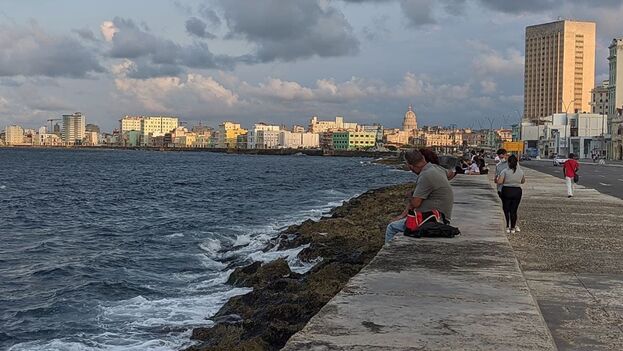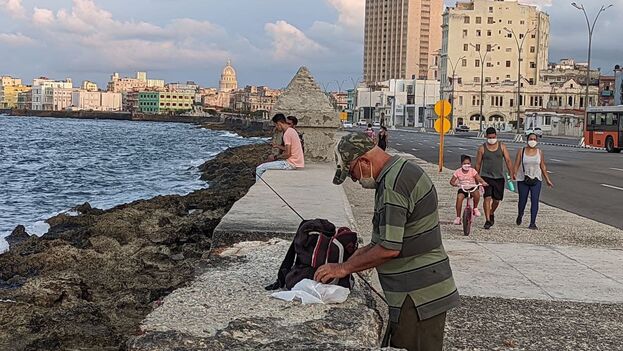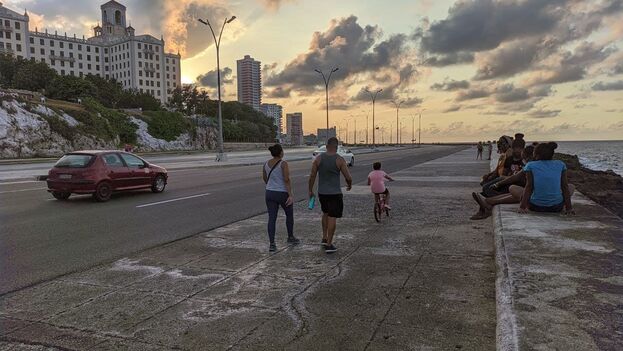
![]() 14ymedio, Havana, 29 September 2021 — Less than a week after restaurants in Havana were allowed to reopen, the municipal government announced on Wednesday that it was relaxing other pandemic-related measures that have been in place for months, such as restrictions on gatherings along the Malecon.
14ymedio, Havana, 29 September 2021 — Less than a week after restaurants in Havana were allowed to reopen, the municipal government announced on Wednesday that it was relaxing other pandemic-related measures that have been in place for months, such as restrictions on gatherings along the Malecon.
Use of “the long bench,” as many locals refer to the iconic seawall, has only been officially allowed since Wednesday. But analyst Julio Aleaga, who lives on Paseo Avenue in Vedado a few yards from the Malecon, reports that people have been using the seaside promenade since restrictions on open-air restaurant seating have been lifted.
The authorities authorized sitting on the wall as long as “sanitary measures to prevent contagion” are respected, including adequate physical distancing, reported the Tribuna de La Habana .
“Today’s is the official confirmation but the daring citizen had already approached the Malecón,” Aleaga insists. “There were people in the morning running along the sidewalk closest to the sea, which was prohibited until last week.”
The resident of the Malecón also said that after 10:30 at night, when the time the curfew begins, “a police truck passes by and whoever is sitting there is taken away.”

The prohibition of sitting on the emblematic wall or even walking along the sidewalk closest to the sea, was a measure that fueled the anger of Havanans, used to spending long hours receiving the sea breeze, finding friends or listening to some music in the place .
As of today, due to the “sustained decrease in confirmed cases and the advance of vaccination,” also “physical exercises can be performed on public roads and in gyms, including places that have artificial ventilation,” said the Governor of the city, Reinaldo García Zapata, at the meeting of the Temporary Working Group for covid-19.
In addition, the opening of beaches and swimming pools was announced, the latter at 50% of their capacity, but the government warned that “adequate food services” could not be ensured in these places and bathers must plan for their own food.

Nor will public transport be strengthened for bathers to go to these areas due to “the economic situation” that the country is experiencing, they justified. In this case, they must travel “in an orderly manner and complying with epidemiological regulations” such as the use of a mask while they are not in the water.
Havana, a coastal city with an ancient tradition of swimming along its coastline, went through the hot summer with its beaches and boardwalk closed to those who wanted to take a dip, even if they only wanted to get close to the waters to cool off in the middle of the intense heat wave.
The closure of the East Beaches to bathers, the most popular in the capital, was a severe blow to the entire economic network of towns such as Santa María, Boca Ciega and Guanabo, in which a good part of the families live by renting rooms , serve food or manage other entertainments for those who come looking for a quiet day in front of the sea.
These strict restrictions have been highly questioned, not only by those who point out the devastating economic effect it has on the private fabric of the area, but also remember that open and ventilated places are the least risky for getting covid-19. Critics question that state stores are kept open behind closed doors and with very long lines, while families who have wanted to enjoy the sea breeze have been penalized with fines.
____________
COLLABORATE WITH OUR WORK: The 14ymedio team is committed to practicing serious journalism that reflects Cuba’s reality in all its depth. Thank you for joining us on this long journey. We invite you to continue supporting us by becoming a member of 14ymedio now. Together we can continue transforming journalism in Cuba.
